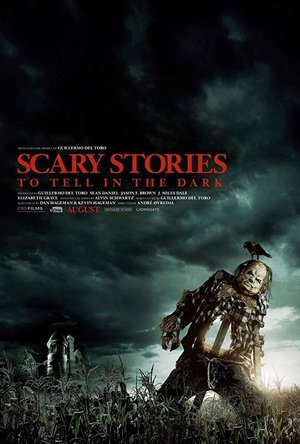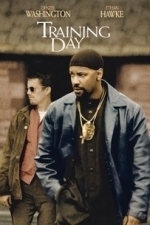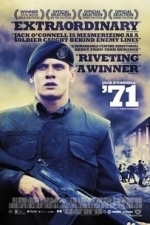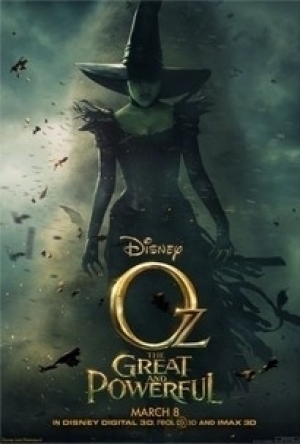Search
Search results
Lee (2222 KP) rated Scary Stories to Tell in the Dark (2019) in Movies
Aug 21, 2019
Obviously I'm not familiar with the Scary Stories To Tell In The Dark books that this movie is based on - a series of three books containing short horror stories for children and drawing heavily on urban legend and folklore for it's subject matter, first published in 1981. Apparently, the series is listed by the American Library Association as being the most challenged series of books from the 1990s, with complaints relating to the violence and disturbing subject matter portrayed within them not being suitable for the children it was aimed at. The illustrations within the book also drew criticism, vividly portraying the nightmare creatures and scenes contained within the stories. Perfect material for a movie version!
That movie version comes from Troll Hunter director André Øvredal and producer/co-writer Guillermo del Toro and attempts a Goosebumps style movie, taking some of the better known stories from the 80+ contained within the books and weaving them into a larger narrative, set in Mill Valley Pennsylvania during the fall of 1968.
It's Halloween and a group of teens are preparing to go out for an evening of trick or treating - applying makeup, getting into their costumes, fishing in the toilet for turds in preparation for a Halloween trick. They head out on their bikes but it's not long before they run into some idiot jocks from their local school, and that turd trick suddenly comes in handy! We've already been introduced to the jocks earlier in the movie, out in a cornfield where they were hitting a creepy looking scarecrow about the head with a baseball bat. Yep, they're certainly going to regret that a little bit later on!
The teens manage to escape the jocks, working their way into a drive through movie that's showing "Night of the Living Dead" and into the car of another teen called Ramón. The group strike up a bond with Ramón after he helps them out and they all decide to go and break into an abandoned local house which is reportedly haunted. They find their way into the basement where legend has it that Sarah Bellows, the daughter of a prominent local family, was locked away in the late 1800s. Horror nerd Stella comes across a book containing short scary stories that were written in blood by Sarah, and she decides to take it with them. As Stella opens the book’s pages, she sees that Sarah’s stories are literally beginning to write themselves - stories that put her friends in some pretty unpleasant situations, stories which immediately become reality the moment they're written. As Stella later puts it, "You don't read the book, the book reads you".
The setup and the scenarios within each story are enjoyable enough and are certainly creepy, however the execution doesn't always work so well and the payoffs aren't quite as scary as I would have liked. The movie also suffers from some slightly dodgy CGI at times too, which doesn't help. That said, I thoroughly enjoyed the final story, and the return to the house in order to try and stop Sarah Bellows worked really well for me. It all ends with a definite opportunity for a sequel and with plenty more scary stories to choose from within the source material, I'm sure we'll be seeing another one soon. Scary Stories to Tell in the Dark taps nicely into the "It" and "Stranger Thing" vibe, with it's group of teens rising up together against evil, and despite it's faults I did have a lot of fun with it. I'm definitely interested in seeing more.
That movie version comes from Troll Hunter director André Øvredal and producer/co-writer Guillermo del Toro and attempts a Goosebumps style movie, taking some of the better known stories from the 80+ contained within the books and weaving them into a larger narrative, set in Mill Valley Pennsylvania during the fall of 1968.
It's Halloween and a group of teens are preparing to go out for an evening of trick or treating - applying makeup, getting into their costumes, fishing in the toilet for turds in preparation for a Halloween trick. They head out on their bikes but it's not long before they run into some idiot jocks from their local school, and that turd trick suddenly comes in handy! We've already been introduced to the jocks earlier in the movie, out in a cornfield where they were hitting a creepy looking scarecrow about the head with a baseball bat. Yep, they're certainly going to regret that a little bit later on!
The teens manage to escape the jocks, working their way into a drive through movie that's showing "Night of the Living Dead" and into the car of another teen called Ramón. The group strike up a bond with Ramón after he helps them out and they all decide to go and break into an abandoned local house which is reportedly haunted. They find their way into the basement where legend has it that Sarah Bellows, the daughter of a prominent local family, was locked away in the late 1800s. Horror nerd Stella comes across a book containing short scary stories that were written in blood by Sarah, and she decides to take it with them. As Stella opens the book’s pages, she sees that Sarah’s stories are literally beginning to write themselves - stories that put her friends in some pretty unpleasant situations, stories which immediately become reality the moment they're written. As Stella later puts it, "You don't read the book, the book reads you".
The setup and the scenarios within each story are enjoyable enough and are certainly creepy, however the execution doesn't always work so well and the payoffs aren't quite as scary as I would have liked. The movie also suffers from some slightly dodgy CGI at times too, which doesn't help. That said, I thoroughly enjoyed the final story, and the return to the house in order to try and stop Sarah Bellows worked really well for me. It all ends with a definite opportunity for a sequel and with plenty more scary stories to choose from within the source material, I'm sure we'll be seeing another one soon. Scary Stories to Tell in the Dark taps nicely into the "It" and "Stranger Thing" vibe, with it's group of teens rising up together against evil, and despite it's faults I did have a lot of fun with it. I'm definitely interested in seeing more.
Matthew Krueger (10051 KP) rated Training Day (2001) in Movies
Jun 11, 2020
King Kong Ain't Got Shit On Ms
I love this movie, i have seen it about 5-7 times now. It is on my top ten films of all time. I love Denzel Performace, he played as a excellent villian, and he should do it more often, cause he doesnt play the villian that much, the only other film I can think of is "American Gangster" and thats it.
The plot: Police drama about a veteran officer who escorts a rookie on his first day with the LAPD's tough inner-city narcotics unit. "Training Day" is a blistering action drama that asks the audience to decide what is necessary, what is heroic and what crosses the line in the harrowing gray zone of fighting urban crime. Does law-abiding law enforcement come at the expense of justice and public safety? If so, do we demand safe streets at any cost?
In June 2003, the American Film Institute named Alonzo Harris the 50th greatest screen villain of all time in its list AFI's 100 Years...100 Heroes & Villains.
Also excellent quotes like..
"You gotta be a wolf to catch a wolf."
"You gotta control your smiles & cries because that's all you have & nobody can take that away from you."
"You wanna go to jail or you wanna go home?"
"To protect the sheep you gotta catch the wolf, and it takes a wolf to catch a wolf."
"I've been planning this all week, son. You talk that crazy shit, I'll make sure that blood gets to the lab. You wanna walk your baby nuts around the block, you won't make it to the corner, but if you're cool, if you're cool... then you're a hero. You're a virgin shooter above suspicion."
"You don't know any stories? Okay, I'll tell you a story. This is a newspaper. It's 90 per cent bullshit, but it's entertaining. That's why I read it, because it entertains me. You won't let me read it, so you entertain me with your bullshit. Tell me a story, right now."
"This shit's chess, it ain't checkers."
"You got a dick. You do have a dick, don't you? Okay, the dick lines up straight like that right? To the right of it and to the left of it are pockets, right? In those pockets are money. Look in either one of 'em, pay the bill."
And of course..
"Aww, you motherfuckers. Okay. Alright. I'm putting cases on all you bitches. Huh. You think you can do this shit... Jake. You think you can do this to me? You motherfuckers will be playing basketball in Pelican Bay when I get finished with you. SHU program, nigga. 23 hour lockdown. I'm the man up in this piece. You'll never see the light of... who the fuck do you think you're fucking with? I'm the police, I run shit around here. You just live here. Yeah, that's right, you better walk away. Go on and walk away... 'cause I'm gonna' burn this motherfucker down. King Kong ain't got shit on me. That's right, that's right. Shit, I don't, fuck. I'm winning anyway, I'm winning... I'm winning any motherfucking way. I can't lose. Yeah, you can shoot me, but you can't kill me."
Its a excellent, phenomenal movie and a must watch film.
The plot: Police drama about a veteran officer who escorts a rookie on his first day with the LAPD's tough inner-city narcotics unit. "Training Day" is a blistering action drama that asks the audience to decide what is necessary, what is heroic and what crosses the line in the harrowing gray zone of fighting urban crime. Does law-abiding law enforcement come at the expense of justice and public safety? If so, do we demand safe streets at any cost?
In June 2003, the American Film Institute named Alonzo Harris the 50th greatest screen villain of all time in its list AFI's 100 Years...100 Heroes & Villains.
Also excellent quotes like..
"You gotta be a wolf to catch a wolf."
"You gotta control your smiles & cries because that's all you have & nobody can take that away from you."
"You wanna go to jail or you wanna go home?"
"To protect the sheep you gotta catch the wolf, and it takes a wolf to catch a wolf."
"I've been planning this all week, son. You talk that crazy shit, I'll make sure that blood gets to the lab. You wanna walk your baby nuts around the block, you won't make it to the corner, but if you're cool, if you're cool... then you're a hero. You're a virgin shooter above suspicion."
"You don't know any stories? Okay, I'll tell you a story. This is a newspaper. It's 90 per cent bullshit, but it's entertaining. That's why I read it, because it entertains me. You won't let me read it, so you entertain me with your bullshit. Tell me a story, right now."
"This shit's chess, it ain't checkers."
"You got a dick. You do have a dick, don't you? Okay, the dick lines up straight like that right? To the right of it and to the left of it are pockets, right? In those pockets are money. Look in either one of 'em, pay the bill."
And of course..
"Aww, you motherfuckers. Okay. Alright. I'm putting cases on all you bitches. Huh. You think you can do this shit... Jake. You think you can do this to me? You motherfuckers will be playing basketball in Pelican Bay when I get finished with you. SHU program, nigga. 23 hour lockdown. I'm the man up in this piece. You'll never see the light of... who the fuck do you think you're fucking with? I'm the police, I run shit around here. You just live here. Yeah, that's right, you better walk away. Go on and walk away... 'cause I'm gonna' burn this motherfucker down. King Kong ain't got shit on me. That's right, that's right. Shit, I don't, fuck. I'm winning anyway, I'm winning... I'm winning any motherfucking way. I can't lose. Yeah, you can shoot me, but you can't kill me."
Its a excellent, phenomenal movie and a must watch film.

NAVIGON Europe
Navigation and Travel
App
Whether on holiday, taking a weekend trip or heading off somewhere as yet unfamiliar – with...

Pinbox - Map Your World
Navigation and Travel
App
Featured by Apple in “Best New Apps”! Plan your next trip. Mark places you want to go. Remember...

Transit • Bus & Subway Times
Navigation and Travel
App
“You won't realize how much time you can save planning until you use this app” - LA Times...
Bong Mines Entertainment (15 KP) rated The Life of Pablo by Kanye West in Music
Jun 7, 2019
Kanye West is an iconic rapper from Chicago, Illinois. Not too long ago, he released his seventh studio album, entitled, “The Life of Pablo“.
ULTRA LIGHT BEAMS
The opening track functions as a Sunday-morning church revival, where Kanye is the ordained minister. He’s standing in the pulpit, preaching a time-sensitive sermon to his loyal congregation.
His message: God over Satan, keep the faith, pray for Paris, pray for parents, and we’re living God’s dream.
West sets the tone and declares where he stands on religious and socially-driven issues.
A Gospel choir emerges. The Dream and Kelly Price reinforce West’s message by singing verses of encouragement, leading to a heartfelt testimonial by Chance The Rapper.
While the collection plates are being filled with hopes of a better tomorrow, Kirk Franklin concludes the service by praying for everyone. He uplifts those who feel they are not good enough or have said, “I’m sorry,” too many times.
Father Stretch My Hands (Pt. 1)
A spiritual figure, Pastor T.L. Barrett, ushers in the second track with praises to The Most High. Future appears for a brief moment and Kid Cudi delivers a stunning chorus.
A liberated West returns to the pulpit and gives a brief, but somewhat explicit testimony of his past and present relationships to Amber Rose and Kim Kardashian.
Father Stretch My Hands (Pt. 2)
West continues his testimony and raps about his personal experiences. He speaks on the importance of returning his wife’s phone calls and not wanting to make the same mistakes his father made. Also, he mentions the passing of the mother in Hollywood, being broke, and the reason why he broke his jaw.
West’s words hit home, making room for another liberated soul to tell his story of triumph.
Desiigner, a newly-signed artist of G.O.O.D. Music, emerges from the underbelly of the ghetto. He raps about getting money illegally, drugs, and violence-familiarized by urban-street hustlers.
Though his grim subject matter contradicts the song’s hopeful message of liberation, it somehow adds mysticism or substance to Kanye’s brutally-honest testimony.
Desiigner, blessed with a futuristic flow, highlights a few things that West’s congregation needs to examine in order to be totally liberated.
FAMOUS
Whenever an important event occurs in an urban community, an after party is sure to follow. And a host of celebrities are always on standby to attend it. The Life of Pablo is no exception.
The fourth song features Rihanna and legendary-producer Swizz Beatz. Also, it contains timeless vocals from Sister Nancy and Nina Simone.
West, no longer in church clothes, stands out lyrically with witty, braggadocios lyrics.
Whether that statement is factual or not, it’s doesn’t really matter because West believes it is.
FEEDBACK
The fifth song serves as a transformational period, where West shows signs of the old Kanye.
West doesn’t need a psychiatrist to diagnose his problems. He does that himself by wearing them on his sleeves.
LOW LIGHTS
On the sixth track, West wrote via Twitter, “I put Low Lights on my album just thinking about all the moms driving their kids to school, then going to work.”
Listeners can now relate to the everyday struggle that mothers endure.
The song features an acapella sample from “So Alive” by Kings of Tomorrow.
The woman gives a grateful-testimony of God’s graciousness over a laid-back, simple piano groove. Her honesty is felt. Also, she sounds liberated because her Creator has accepted her for who she is.
HIGH LIGHTS
From lows to high, the seventh track is in direct correlation to “Low Lights”.
West and Young Thug put on their festive robes because it’s time to celebrate life. El Debarge and The Dream chime in, and West addresses a lingering issue.
But this is only the beginning. West finishes strong with more thought-provoking lyrics.
FREESTYLE 4
The eighth track features Desiigner. Again, when he and West are together, all hell breaks loose.
The once festive scene transforms into a grimy underworld filled with a prostitute that West is explicitly lusting after. The temptation makes it difficult for him to stand on his opening statement of Jesus over Satan. But the power of darkness is more powerful than West thinks. So, he subconsciously indulges in sexual misconduct.
I LOVE KANYE
On the ninth track, West realizes that he’s at war with himself. The old Kanye, known for chopping up soul records is fighting against the new Kanye that everyone hates. But Kanye wants to go back to being sweet again if that’s even possible. His multiple egos are fighting for control over the ‘real’ Kanye.
WAVE
West doesn’t stare in the mirror for too long. On the tenth track, redemption happens. Chris Brown, disguised as an angel, comes to West’s aid by providing much-needed light.
Miraculously, the sun emerges from the shade, a bird flies out its cage, and a nostalgic feeling is felt.
West realizes that nothing is impossible because waves don’t die and feelings don’t really go away.
FML (FOR MY LADY)
On the eleventh track, West realizes what’s really important to him and that’s his wife. Someone he won’t jeopardize for no other woman. Also, his children are all layers of his soul.
The Weeknd appears in the form of West’s conscience.
West remains focused and listeners can feel the positive aura of God surrounding him. He is determined to remain faithful to only Kim, no other woman.
REAL FRIENDS
West continues his introspective outlook and raps about trust issues that everyone can relate to. His honest, down-to-earth lyrics, mixed in with Ty Dolla $ign’s vocals, paints a vivid picture. Also, it forms a collectible souvenir that hangs nicely in listeners’ collective memories.
WOLVES
The thirteenth track provides a cooling effect with wild emotions and bizarre-sounds.
The setting, maybe an extraterritorial realm in West’s subconscious mind. Perhaps, it’s the Milky Way Galaxy or a dream-state of Saturn.
A time for relaxation, preparing listeners for a surprise guest.
SILVER SURFER INTERMISSION
The fourteenth track features a phone conversation between incarcerated Max B and French Montana. Also, Max voices his gratitude to West for showing him love.
30 HOURS
On the fifteenth track, West takes a trip down memory lane and raps about an ex-girlfriend that he used to drive 30-hours to see. He used to drive from Chicago to St. Louis, St. Louis to Chicago. He recalls the good times they shared. But unfortunately, her infidelity was the reason why they broke up.
NO PARTIES IN L.A.
The sixteenth track will go down in history as a legendary bar-fest between two elite emcees. Kendrick Lamar and West rap with dope punchlines and clever metaphors over a Madlib-produced track. Once again, West is flowing like the old Kanye that people love.
FACTS
The seventeenth track is a standout anthem where West brags that Yeezy just jumped over Jumpman. He’s in boss-mode, talking that big-money talk.
FADE
The final track features Post Malone and Ty Dollar $ign. The song has a reoccurring sample from Rare Earth, “Your love is fading/I feel it fade.”
The Eli Linnetz-directed video shows Teyana Taylor explicitly dancing.
CONCLUSION
Kanye West’s “The Life of Pablo” is a memorable hip-hop album with solid content and heavy replay value.
https://www.bongminesentertainment.com/kanye-west-life-pablo/
ULTRA LIGHT BEAMS
The opening track functions as a Sunday-morning church revival, where Kanye is the ordained minister. He’s standing in the pulpit, preaching a time-sensitive sermon to his loyal congregation.
His message: God over Satan, keep the faith, pray for Paris, pray for parents, and we’re living God’s dream.
West sets the tone and declares where he stands on religious and socially-driven issues.
A Gospel choir emerges. The Dream and Kelly Price reinforce West’s message by singing verses of encouragement, leading to a heartfelt testimonial by Chance The Rapper.
While the collection plates are being filled with hopes of a better tomorrow, Kirk Franklin concludes the service by praying for everyone. He uplifts those who feel they are not good enough or have said, “I’m sorry,” too many times.
Father Stretch My Hands (Pt. 1)
A spiritual figure, Pastor T.L. Barrett, ushers in the second track with praises to The Most High. Future appears for a brief moment and Kid Cudi delivers a stunning chorus.
A liberated West returns to the pulpit and gives a brief, but somewhat explicit testimony of his past and present relationships to Amber Rose and Kim Kardashian.
Father Stretch My Hands (Pt. 2)
West continues his testimony and raps about his personal experiences. He speaks on the importance of returning his wife’s phone calls and not wanting to make the same mistakes his father made. Also, he mentions the passing of the mother in Hollywood, being broke, and the reason why he broke his jaw.
West’s words hit home, making room for another liberated soul to tell his story of triumph.
Desiigner, a newly-signed artist of G.O.O.D. Music, emerges from the underbelly of the ghetto. He raps about getting money illegally, drugs, and violence-familiarized by urban-street hustlers.
Though his grim subject matter contradicts the song’s hopeful message of liberation, it somehow adds mysticism or substance to Kanye’s brutally-honest testimony.
Desiigner, blessed with a futuristic flow, highlights a few things that West’s congregation needs to examine in order to be totally liberated.
FAMOUS
Whenever an important event occurs in an urban community, an after party is sure to follow. And a host of celebrities are always on standby to attend it. The Life of Pablo is no exception.
The fourth song features Rihanna and legendary-producer Swizz Beatz. Also, it contains timeless vocals from Sister Nancy and Nina Simone.
West, no longer in church clothes, stands out lyrically with witty, braggadocios lyrics.
Whether that statement is factual or not, it’s doesn’t really matter because West believes it is.
FEEDBACK
The fifth song serves as a transformational period, where West shows signs of the old Kanye.
West doesn’t need a psychiatrist to diagnose his problems. He does that himself by wearing them on his sleeves.
LOW LIGHTS
On the sixth track, West wrote via Twitter, “I put Low Lights on my album just thinking about all the moms driving their kids to school, then going to work.”
Listeners can now relate to the everyday struggle that mothers endure.
The song features an acapella sample from “So Alive” by Kings of Tomorrow.
The woman gives a grateful-testimony of God’s graciousness over a laid-back, simple piano groove. Her honesty is felt. Also, she sounds liberated because her Creator has accepted her for who she is.
HIGH LIGHTS
From lows to high, the seventh track is in direct correlation to “Low Lights”.
West and Young Thug put on their festive robes because it’s time to celebrate life. El Debarge and The Dream chime in, and West addresses a lingering issue.
But this is only the beginning. West finishes strong with more thought-provoking lyrics.
FREESTYLE 4
The eighth track features Desiigner. Again, when he and West are together, all hell breaks loose.
The once festive scene transforms into a grimy underworld filled with a prostitute that West is explicitly lusting after. The temptation makes it difficult for him to stand on his opening statement of Jesus over Satan. But the power of darkness is more powerful than West thinks. So, he subconsciously indulges in sexual misconduct.
I LOVE KANYE
On the ninth track, West realizes that he’s at war with himself. The old Kanye, known for chopping up soul records is fighting against the new Kanye that everyone hates. But Kanye wants to go back to being sweet again if that’s even possible. His multiple egos are fighting for control over the ‘real’ Kanye.
WAVE
West doesn’t stare in the mirror for too long. On the tenth track, redemption happens. Chris Brown, disguised as an angel, comes to West’s aid by providing much-needed light.
Miraculously, the sun emerges from the shade, a bird flies out its cage, and a nostalgic feeling is felt.
West realizes that nothing is impossible because waves don’t die and feelings don’t really go away.
FML (FOR MY LADY)
On the eleventh track, West realizes what’s really important to him and that’s his wife. Someone he won’t jeopardize for no other woman. Also, his children are all layers of his soul.
The Weeknd appears in the form of West’s conscience.
West remains focused and listeners can feel the positive aura of God surrounding him. He is determined to remain faithful to only Kim, no other woman.
REAL FRIENDS
West continues his introspective outlook and raps about trust issues that everyone can relate to. His honest, down-to-earth lyrics, mixed in with Ty Dolla $ign’s vocals, paints a vivid picture. Also, it forms a collectible souvenir that hangs nicely in listeners’ collective memories.
WOLVES
The thirteenth track provides a cooling effect with wild emotions and bizarre-sounds.
The setting, maybe an extraterritorial realm in West’s subconscious mind. Perhaps, it’s the Milky Way Galaxy or a dream-state of Saturn.
A time for relaxation, preparing listeners for a surprise guest.
SILVER SURFER INTERMISSION
The fourteenth track features a phone conversation between incarcerated Max B and French Montana. Also, Max voices his gratitude to West for showing him love.
30 HOURS
On the fifteenth track, West takes a trip down memory lane and raps about an ex-girlfriend that he used to drive 30-hours to see. He used to drive from Chicago to St. Louis, St. Louis to Chicago. He recalls the good times they shared. But unfortunately, her infidelity was the reason why they broke up.
NO PARTIES IN L.A.
The sixteenth track will go down in history as a legendary bar-fest between two elite emcees. Kendrick Lamar and West rap with dope punchlines and clever metaphors over a Madlib-produced track. Once again, West is flowing like the old Kanye that people love.
FACTS
The seventeenth track is a standout anthem where West brags that Yeezy just jumped over Jumpman. He’s in boss-mode, talking that big-money talk.
FADE
The final track features Post Malone and Ty Dollar $ign. The song has a reoccurring sample from Rare Earth, “Your love is fading/I feel it fade.”
The Eli Linnetz-directed video shows Teyana Taylor explicitly dancing.
CONCLUSION
Kanye West’s “The Life of Pablo” is a memorable hip-hop album with solid content and heavy replay value.
https://www.bongminesentertainment.com/kanye-west-life-pablo/
graveyardgremlin (7194 KP) rated Tempest Rising (Jane True, #1) in Books
Feb 15, 2019
Horror, Romance, Mystery, Urban Fantasy? None of those really, though it falls under the UF genre.
I'm not quite sure why TEMPEST RISING is categorized as horror (fantasy - yes, horror - no), as there is nothing horrific at all about the book, except maybe a little bit of violence. The book was slow to start and, sadly, it never really got very far, and ended up more boring than not. The world building was good, and learning about the different species was interesting, but most of it was, at best, just okay.
The character development was next to nil. Jane starts off decent enough, could be fairly witty, but as the book progressed she became less likeable and her inner monologue started to grate on my nerves. Even though she's had some tough experiences, overall she came across as rather juvenile and I wasn't very impressed with her. And how many 'duh' moments could one person possibly have? Yes, she's new to the 'supe' world, yes, she doesn't know all there is to it, but c'mon, use some smarts girl, it's not that hard to put two and two together. So now it comes to Ryu. Oh, Ryu, ye of no personality. You may be hot, but that's all you have going for you. Talk about a flat character, he was pretty darn boring, which was unfortunate because he took up a big part of the book, and I just plain didn't like him. I got pretty sick of Jane and Ryu going at it like rabbits all the time, which would have been better used by giving him some much needed personality. Along with that, maybe an explanation of how Ryu's Japanese (I'm guessing because of his first name and almond eyes) and who also just happens to be a baobhan sith, which is a type of female vampire, from Scotland at that. The most interesting characters were Anyan, and the town pariah's (that's Jane) many friends, both human and non. How a social outcast has so many friends is beyond me, but you know Jane is despised by her woe-is-me attitude and the two people who hate her. Despite what she thinks, I highly doubt the town revolves around her.
Some of the author's descriptions are confusing and I had to reread them to 'get' it. How can something be both squat and tall (pg. 216), pray tell? I'm still pondering that one. Also, the descriptions and analogies could be really odd, and not in a good way, more in a 'where in the world did that come from?' and 'what the heck?' sorta ways. Like what was up with Ryu's laugh? Barking like a seal, giggling like a choking Pomeranian, and whatever other weird ways he laughed. I'm sorry, but that's not very attractive, but I guess it was supposed to be funny and endearing. Editing problems arose when I couldn't figure out if a certain creature was a goblin or gremlin (there is a difference). I finally figured it out when goblin edged out gremlin for the lead. A mistake dealing with the Porsche's trunk was another minor detail that I picked up on, but most people would probably miss it. I only noticed because I've wanted a Porsche since I was ten. :P
The end does show some promise that Jane might actually get some grit, being a half-selkie is a nice change from the supernatural usual after all, and Ryu just might not be featured as much. So, even with all the problems I had with the book, which did unfortunately top what I did like about the book, I probably will check out the next book in the series.
I'm not quite sure why TEMPEST RISING is categorized as horror (fantasy - yes, horror - no), as there is nothing horrific at all about the book, except maybe a little bit of violence. The book was slow to start and, sadly, it never really got very far, and ended up more boring than not. The world building was good, and learning about the different species was interesting, but most of it was, at best, just okay.
The character development was next to nil. Jane starts off decent enough, could be fairly witty, but as the book progressed she became less likeable and her inner monologue started to grate on my nerves. Even though she's had some tough experiences, overall she came across as rather juvenile and I wasn't very impressed with her. And how many 'duh' moments could one person possibly have? Yes, she's new to the 'supe' world, yes, she doesn't know all there is to it, but c'mon, use some smarts girl, it's not that hard to put two and two together. So now it comes to Ryu. Oh, Ryu, ye of no personality. You may be hot, but that's all you have going for you. Talk about a flat character, he was pretty darn boring, which was unfortunate because he took up a big part of the book, and I just plain didn't like him. I got pretty sick of Jane and Ryu going at it like rabbits all the time, which would have been better used by giving him some much needed personality. Along with that, maybe an explanation of how Ryu's Japanese (I'm guessing because of his first name and almond eyes) and who also just happens to be a baobhan sith, which is a type of female vampire, from Scotland at that. The most interesting characters were Anyan, and the town pariah's (that's Jane) many friends, both human and non. How a social outcast has so many friends is beyond me, but you know Jane is despised by her woe-is-me attitude and the two people who hate her. Despite what she thinks, I highly doubt the town revolves around her.
Some of the author's descriptions are confusing and I had to reread them to 'get' it. How can something be both squat and tall (pg. 216), pray tell? I'm still pondering that one. Also, the descriptions and analogies could be really odd, and not in a good way, more in a 'where in the world did that come from?' and 'what the heck?' sorta ways. Like what was up with Ryu's laugh? Barking like a seal, giggling like a choking Pomeranian, and whatever other weird ways he laughed. I'm sorry, but that's not very attractive, but I guess it was supposed to be funny and endearing. Editing problems arose when I couldn't figure out if a certain creature was a goblin or gremlin (there is a difference). I finally figured it out when goblin edged out gremlin for the lead. A mistake dealing with the Porsche's trunk was another minor detail that I picked up on, but most people would probably miss it. I only noticed because I've wanted a Porsche since I was ten. :P
The end does show some promise that Jane might actually get some grit, being a half-selkie is a nice change from the supernatural usual after all, and Ryu just might not be featured as much. So, even with all the problems I had with the book, which did unfortunately top what I did like about the book, I probably will check out the next book in the series.
Story: 71 starts as we see Gary Hook (O’Connell) going through his training with his regiment before they get deployed to Belfast to deal with the riot situation. In Ireland the regiment receive their instructions and onto the Catholic side of the war. When the riots get out of hand Gary finds himself on the wrong side of the barrier alone and unarmed in the Irish territory.
With tensions rising Gary finds himself in the middle of the battle not knowing which side to trust as both side are preparing to attack each other as Gary learns the harsh reality of what these riots are causing.
71 puts us into the middle of the Irish riots showing just one soldier’s experience behind enemy lines, this works well. My issue with the story is unless you know the history which I only know the basics you are left kind of wondering why the riots are happening in the first place. Another problem I found was telling what was going on with the supporting characters like who was on whose side which I do understand adds to the mystery but in this situation we should be able to identify them easily. As a film about survival in an urban setting this is great though.
Actor Review
Jack O’Connell: Gary Hook is the young soldier who is on his first mission on the streets on Belfast during the riots of 71, trying to receive a lost weapon he gets separated by his unit and stranded alone behind enemy lines never sure who to trust. Jack is great in this leading role in what was an outstanding year for the young actor.gary
Sam Reid: Lt. Armitage is one of the men that wants to start searching for Gary but constantly gets put down Captain Browning. Sam is solid in this role but doesn’t get enough screen time.
Sean Harris: Captain Sandy Browning is the man running the situation he knows that Gary is alive but really is playing both sides of the battle. Sean is also solid but only in a supporting role.
Killian Scott: Quinn is one of the leaders out trying to kill Gary, he takes his men and boys out on the streets on the hunt for him and will hurt anyone who gets in his way. Killian is good in what seems like one of the primary villains.
Support Cast: 71 has a large supporting cast but working out which side they are on gets confusing at times.
Director Review: Yann Demange – Yann gives us wonderfully shot sequences throughout but not enough back story to the events on the film.
Action: 71 has intensely shot action sequences involved.
Thriller: 71 keeps us on edge as we watch Gary trying to survive the warzone.
War: 71 puts us into a warzone as we see Gary trying to avoid conflict seemingly around every single corner.
Settings: 71 puts us in the warzone of the Belfast streets which really works to pull us into the story.
Special Effects: 71 has great effects when needed without having to just go overboard with them.
Suggestion: 71 is one for fans of the genre but otherwise people might find it slightly hard to keep up with. (War Film Fans Watch)
Best Part: Bomb shock.
Worst Part: Not enough history of the events.
Believability: The riots were real but story is fictional.
Chances of Tears: No
Chances of Sequel: No
Post Credits Scene: No
Similar Too: Behind Enemy Lines
Awards: Nominated for One BAFTA.
Oscar Chances: No
Runtime: 1 Hour 39 Minutes
Trivia: Most scenes within the film were shot in Northern England, not in the film’s setting of Belfast.
Overall: Good history war thriller that is intense but never fully drags you into believing everything.
https://moviesreview101.com/2016/11/08/71-2014/
With tensions rising Gary finds himself in the middle of the battle not knowing which side to trust as both side are preparing to attack each other as Gary learns the harsh reality of what these riots are causing.
71 puts us into the middle of the Irish riots showing just one soldier’s experience behind enemy lines, this works well. My issue with the story is unless you know the history which I only know the basics you are left kind of wondering why the riots are happening in the first place. Another problem I found was telling what was going on with the supporting characters like who was on whose side which I do understand adds to the mystery but in this situation we should be able to identify them easily. As a film about survival in an urban setting this is great though.
Actor Review
Jack O’Connell: Gary Hook is the young soldier who is on his first mission on the streets on Belfast during the riots of 71, trying to receive a lost weapon he gets separated by his unit and stranded alone behind enemy lines never sure who to trust. Jack is great in this leading role in what was an outstanding year for the young actor.gary
Sam Reid: Lt. Armitage is one of the men that wants to start searching for Gary but constantly gets put down Captain Browning. Sam is solid in this role but doesn’t get enough screen time.
Sean Harris: Captain Sandy Browning is the man running the situation he knows that Gary is alive but really is playing both sides of the battle. Sean is also solid but only in a supporting role.
Killian Scott: Quinn is one of the leaders out trying to kill Gary, he takes his men and boys out on the streets on the hunt for him and will hurt anyone who gets in his way. Killian is good in what seems like one of the primary villains.
Support Cast: 71 has a large supporting cast but working out which side they are on gets confusing at times.
Director Review: Yann Demange – Yann gives us wonderfully shot sequences throughout but not enough back story to the events on the film.
Action: 71 has intensely shot action sequences involved.
Thriller: 71 keeps us on edge as we watch Gary trying to survive the warzone.
War: 71 puts us into a warzone as we see Gary trying to avoid conflict seemingly around every single corner.
Settings: 71 puts us in the warzone of the Belfast streets which really works to pull us into the story.
Special Effects: 71 has great effects when needed without having to just go overboard with them.
Suggestion: 71 is one for fans of the genre but otherwise people might find it slightly hard to keep up with. (War Film Fans Watch)
Best Part: Bomb shock.
Worst Part: Not enough history of the events.
Believability: The riots were real but story is fictional.
Chances of Tears: No
Chances of Sequel: No
Post Credits Scene: No
Similar Too: Behind Enemy Lines
Awards: Nominated for One BAFTA.
Oscar Chances: No
Runtime: 1 Hour 39 Minutes
Trivia: Most scenes within the film were shot in Northern England, not in the film’s setting of Belfast.
Overall: Good history war thriller that is intense but never fully drags you into believing everything.
https://moviesreview101.com/2016/11/08/71-2014/
Gareth von Kallenbach (980 KP) rated Oz the Great and Powerful (2013) in Movies
Aug 7, 2019
Taking on a movie as beloved as “The Wizard of Oz” is a daunting task. The iconic Judy Garland film is considered a classic and many of the songs from the film have remained part of our culture since it was released in 1939. Despite several book sequels, the attempts to continue the series have had little success as there have been animated films as well as an urban remake, “The Wiz”, which also failed to reach the success of the original. Director Sam Raimi opted to do an original prequel story that tells of how the fabled Wizard of Oz came to be.
Oz (James Franco), is a small-time magician toiling away in small circus in Kansas in 1905. Life on the road has allowed him to be a womanizer and an egomaniac who dreams of greatness. When his actions catch up with him, Oz is forced to flee and takes refuge from an angry mob in a hot air balloon. An unexpected storm funnel grabs the balloon, and whisks Oz to a dazzling and colorful world filled with all manner of strange creatures and wonders.
Upon his arrival, Oz is greeted by Theodora (Mila Kunis), who believes that Oz is the great wizard that legend has said will arrive to save the land and rule the people in a kind and just way. It is revealed that the land is under siege from a wicked witch, and a prophecy indicates a great wizard will arrive with the same name as the land, and will save the day.
Naturally Oz does not believe this but is more than willing to charm Theodora and her sister Evanora (Rachel Weisz), and plot to get his hands on the abundant gold that will come with his appointment as the great wizard. Oz learns that in order to take the throne, he has to defeat another witch (Michelle Williams), and sets off on a journey to the Dark Forest with his flying monkey companion Finley (Zach Braff). Along the journey, Oz learns first hand of the horrors the witch has unleashed on the unsuspecting and learns that his selfish behavior has serious consequences not just for himself, but for innocent people as well. This leads to some serious soul-searching and a confrontation that will force Oz to become the man that many believe he is, less they all perish.
The film has some great visuals as Raimi wisely shot the movie in 3D and mixed CGI with some very impressive sets. It is clear that much of the film is shot against a CGI backdrop but the visual wonder of the film is something to behold. The biggest issues I had with the film were that it was slow-paced and did drag in several parts. Franco does his best to play up the seedier side of Oz, but makes some very odd facial expressions throughout the film that seem very forced and out of place for the film and the situations he finds himself in. Kunis and Weisz make excellent witches and their backstory is a very interesting and an integral part of Dorothy’s adventures in the original film. Williams does well with her role but never seems to develop the needed chemistry with Franco. I was also surprised that the film was very light on musical numbers as there was only a hint of one that was quickly halted by Franco. “Oz: The Great and Powerful” is a visually enjoyable film that sets the stage well for the original film and Raimi is to be praised for taking on such sacred material and providing a new chapter for the modern generation. While it is not likely to be considered a classic like the original film, it is still a worthy chapter in the series which will provide good nostalgic entertainment for fans new and old alike.
Oz (James Franco), is a small-time magician toiling away in small circus in Kansas in 1905. Life on the road has allowed him to be a womanizer and an egomaniac who dreams of greatness. When his actions catch up with him, Oz is forced to flee and takes refuge from an angry mob in a hot air balloon. An unexpected storm funnel grabs the balloon, and whisks Oz to a dazzling and colorful world filled with all manner of strange creatures and wonders.
Upon his arrival, Oz is greeted by Theodora (Mila Kunis), who believes that Oz is the great wizard that legend has said will arrive to save the land and rule the people in a kind and just way. It is revealed that the land is under siege from a wicked witch, and a prophecy indicates a great wizard will arrive with the same name as the land, and will save the day.
Naturally Oz does not believe this but is more than willing to charm Theodora and her sister Evanora (Rachel Weisz), and plot to get his hands on the abundant gold that will come with his appointment as the great wizard. Oz learns that in order to take the throne, he has to defeat another witch (Michelle Williams), and sets off on a journey to the Dark Forest with his flying monkey companion Finley (Zach Braff). Along the journey, Oz learns first hand of the horrors the witch has unleashed on the unsuspecting and learns that his selfish behavior has serious consequences not just for himself, but for innocent people as well. This leads to some serious soul-searching and a confrontation that will force Oz to become the man that many believe he is, less they all perish.
The film has some great visuals as Raimi wisely shot the movie in 3D and mixed CGI with some very impressive sets. It is clear that much of the film is shot against a CGI backdrop but the visual wonder of the film is something to behold. The biggest issues I had with the film were that it was slow-paced and did drag in several parts. Franco does his best to play up the seedier side of Oz, but makes some very odd facial expressions throughout the film that seem very forced and out of place for the film and the situations he finds himself in. Kunis and Weisz make excellent witches and their backstory is a very interesting and an integral part of Dorothy’s adventures in the original film. Williams does well with her role but never seems to develop the needed chemistry with Franco. I was also surprised that the film was very light on musical numbers as there was only a hint of one that was quickly halted by Franco. “Oz: The Great and Powerful” is a visually enjoyable film that sets the stage well for the original film and Raimi is to be praised for taking on such sacred material and providing a new chapter for the modern generation. While it is not likely to be considered a classic like the original film, it is still a worthy chapter in the series which will provide good nostalgic entertainment for fans new and old alike.






